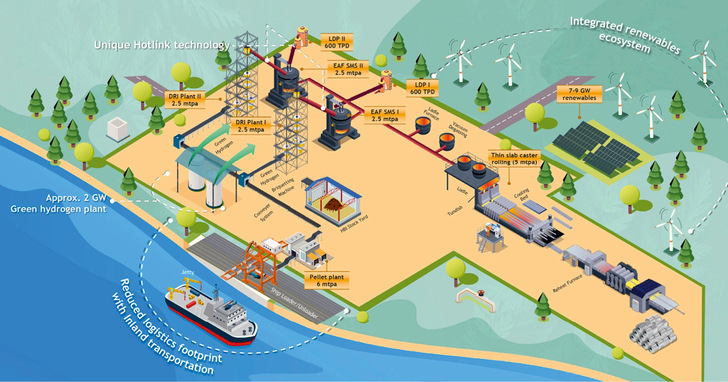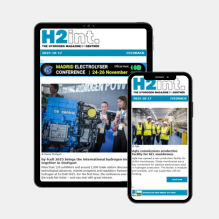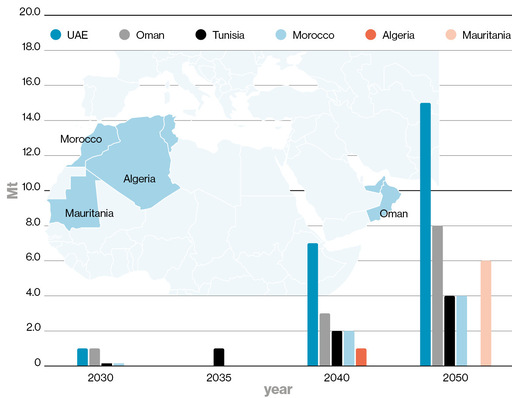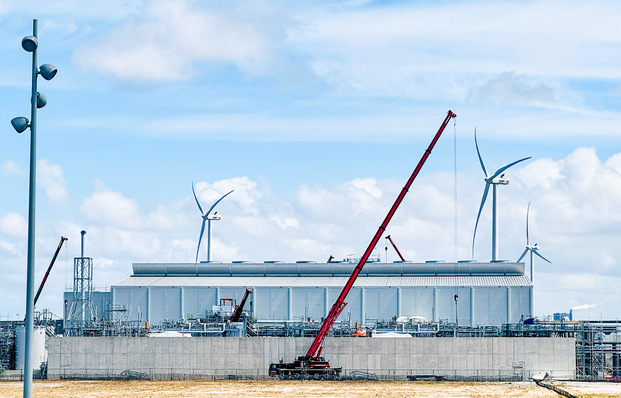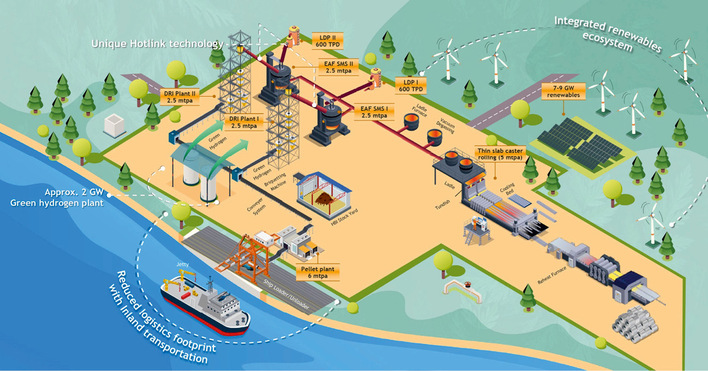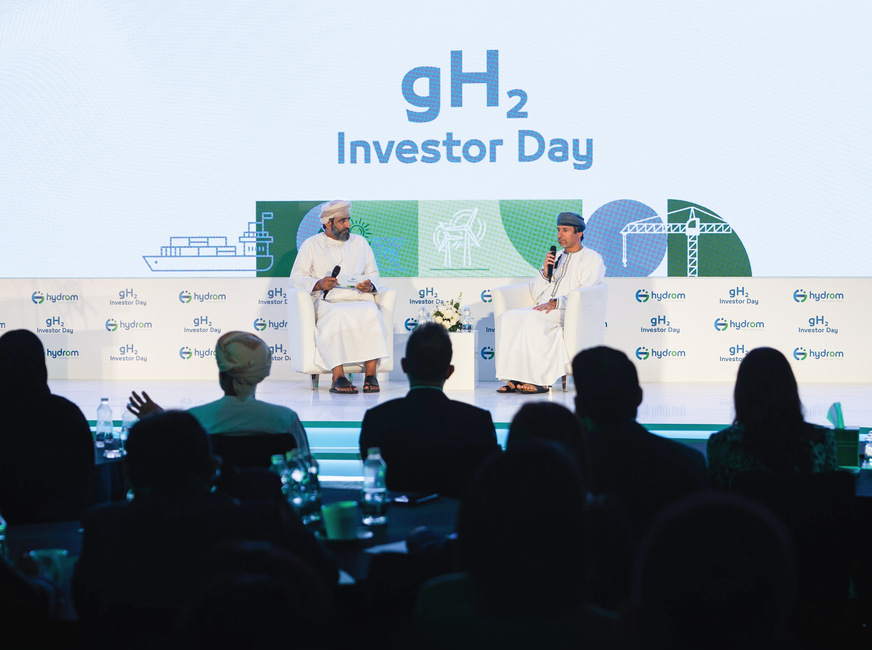
© Hydrom
Germany is firmly planned as a customer for green hydrogen “made in Oman.” Oman is focusing on a partnership-based approach (see H2int. 1/2023). Currently, the joint development of technologies for the production and transport of green hydrogen is the main focus. With the help of international alliances and jointly operated infrastructure, Oman aims to become independent of its dwindling oil and gas reserves.
The production of green hydrogen is expected to increase to around 1 to 1.5 million tons per year (MTPA) by 2030 and up to 8.5 MTPA by 2050. With these targets, Oman ranks second in North Africa and the Middle East (MENA) behind the United Arab Emirates. The estimated investments for this are around $150 billion. From 2030, the first ships are expected to deliver liquid hydrogen to Amsterdam. The contracting parties reached a corresponding agreement during the UN Climate Conference COP28 in Dubai in December 2023. Their goal is a commercial liquid hydrogen route. In mid-April 2025, the Sultan of Oman signed a development agreement in the Netherlands to bring liquid hydrogen to Europe via Amsterdam and specifically to Duisburg.
Seeking consortia for hydrogen production
In Oman, around 50,000 square kilometers of land in three zones are available for green hydrogen projects. “The projects are awarded auction-style by Hydrom, the orchestrator of hydrogen development in Oman, to consortia,” explains Sousann El-Faksch, who has been office manager of the German Chamber of Foreign Trade (AHK) in Muscat for many years. Hydrom is a state organization founded specifically for this purpose in 2022. The composition of the consortia is defined and covers the value chain.
• A project developer is responsible for planning, developing, and implementing the entire project, including the construction of infrastructure such as solar and wind power plants and hydrogen production facilities.
• A technology provider must be involved, supplying electrolyzers, for example.
• Additionally, there must be an offtaker who uses the hydrogen and a processor who produces products such as green steel, methanol, or ammonia for export using the hydrogen.
Hydrom plans and coordinates the necessary infrastructure, such as power transmission networks, water and hydrogen pipelines, and desalination plants. The project partners can access these for a fee, explains El-Faksch.
At the end of April 2023, the third auction for the land to be awarded began. Bids can be submitted by both hydrogen producers and companies from downstream industries, such as manufacturers of green steel or fertilizers. The awarding of projects is expected between the fourth quarter of 2023 and the first quarter of 2024.
Great ambitions and good conditions
These are signs that Oman seriously wants to become a pioneer state in green hydrogen in the Gulf.
Experts from the International Energy Agency (IEA) and the German Institute for International and Security Affairs also see ideal conditions for Oman's hydrogen plans. The mainland's main coast alone is more than 2,000 km long. There are facilities for desalinating seawater, the wind blows around the clock, and the sun shines at least eight hours daily, in some areas more than ten hours. Oman also already maintains good contacts with Germany and is considered a neutral mediator in the Gulf region.
“Oman itself is very stable – both in terms of trade relations and domestic politics and in relation to its neighbors. The Yemen conflict and other regional disputes will not spill over into the country thanks to Oman’s diplomatic skill and border security,” says Dr. Dawud Ansari. He works for the German Institute for International and Security Affairs (SWP) in Berlin and is also President of the Majan Council for Foresight, Strategic Affairs and Energy (formerly Majan Centre for Renewable Energy and Energy Efficiency, MCREEE) based in Oman. This think tank aims to expand the role of local expertise as an independent, privately funded research institution.
Oman's Energy Minister Salim Al Aufi has signed corresponding Memoranda of Understanding (MoU) for cooperation in Germany to develop the market for green hydrogen. At an investor day in the Omani capital Muscat, he emphasized the seriousness of his plans to reach the German market via the ports of Amsterdam and Rotterdam.
Among the visiting investors were many German company representatives, such as Konstantin von Oldenburg, Managing Director at VNG. The Leipzig-based company sees itself as a future wholesaler and supplier of hydrogen and wants to help shape market development, according to its own statements. To this end, it signed a Memorandum of Understanding (MoU) to establish a German-Omani supply chain for green hydrogen and ammonia. Another step in the energy partnership between the two countries is an agreement on the purchase and sale of liquefied natural gas (LNG) between Oman LNG and Securing Energy for Europe (SEFE) Company. The supply contract covers 0.4 million tons of liquefied natural gas (LNG) annually between 2026 and 2029.
Lack of demand
Despite these agreements, experts see the lack of demand as a critical point. While there are initial purchase agreements with countries like Korea and Japan, concrete interest from Europe has so far often been lacking, partly due to insufficient political backing. “For German hydrogen consumers, however, this presents a remarkable opportunity: a country that is literally waiting to export hydrogen is currently looking for buyers in project consortia,” emphasizes Dawud Ansari, who works as a scientist for the German Institute for International and Security Affairs in Berlin and for the Majan Council for Foresight in Oman. Ansari attests to Oman’s unique institutional seriousness in the region regarding its hydrogen plans.
“Originally, the Omanis envisioned the situation similar to oil and gas production: raw materials are offered and purchased. But with hydrogen, a complete production and value chain must first be developed and built,” says Dr. Guido Hora, responsible for business development and strategy at the Fraunhofer Institute for Surface Engineering and Thin Films IST in Braunschweig. On the research side, he accompanies Salzgitter AG, which will rely on the import of green hydrogen in the medium term for its “Salcos” program for low-CO2 steel production – and sees great opportunities in Oman.
Fraunhofer IST offers business-oriented training and further education for specialists in Oman. The German University of Technology (GUtech), founded in 2007 with RWTH Aachen, also helps. It is the only German university on the Arabian Peninsula. The Master’s program (MSc) in Hydrogen Economy and Technology is tailored to professionals from the oil and gas sector. “The program was developed in close collaboration with leading German universities such as Ingolstadt and RWTH Aachen to ensure it reflects the latest advances and best practices in the field,” says the responsible dean, Prof. Dr. Osman Bargouth.
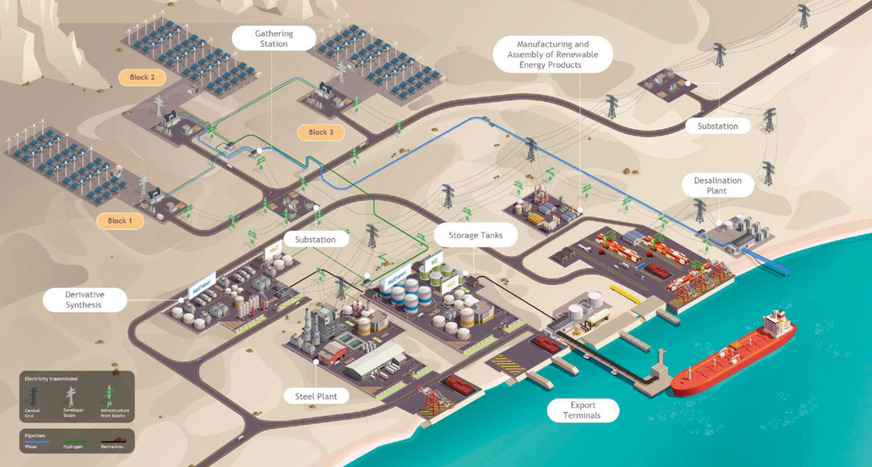
© Hydrom
H2Global helps with market development
Abdulaziz Al Shidani, manager of the state hydrogen organization Hydrom, sees diverse roles for companies from Germany: “They can be project developers, financial partners, providers of necessary equipment and materials, as well as potential industrial customers.” For this, common standards and certification systems within the hydrogen economy are important. Likewise, sustainably effective, economic business models must be developed. The H2Global Foundation offers one possibility.
Pauline Raabe, spokesperson for the Hamburg-based foundation, explains: “H2Global helps overcome challenges of the not-yet-existing market for clean hydrogen and its derivatives. An intermediary conducts auctions on both the production and purchase sides, which always lead to a contract with the highest bidder. In this way, investment security is created for the producer, and the long-awaited price signals are triggered on the purchase side. The difference costs between the production price and the sales price are offset by a donor, usually governments.” The goal: Production starts, and the price signals support the emergence of the hydrogen market.
“The Omani government has expressed interest in using this instrument to accelerate the growth of the clean hydrogen market,” says Raabe, who is responsible for the Near and Middle East region at the foundation.
German companies want to supply technology
For German companies, the green hydrogen industry in Oman offers a new export market. According to the Majan Council think tank, Siemens Energy plans to significantly increase its production capacity for electrolyzer modules to supply them to Oman. Bosch is positioning itself as a supplier for PEM electrolysis stacks. And Thyssenkrupp Nucera has also declared its intention to sell technology to Oman. They also receive help from the German government. As part of its climate strategy adopted in 2023, it secures such business through a so-called Hermes guarantee. This means that German suppliers do not have to worry about payment defaults.
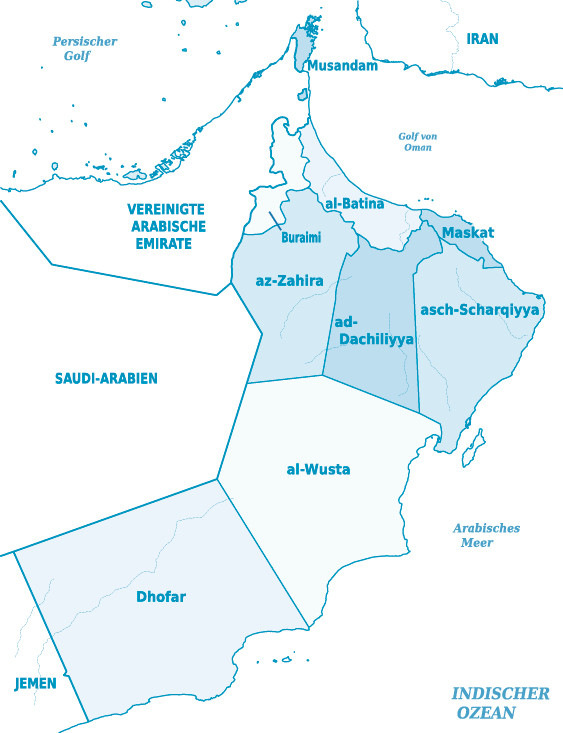
© Wikimedia Commons / TUBS
Key facts about Oman
With an area of 309,500 km², Oman is about the size of Italy but has only 5.5 million inhabitants. Even the coast is relatively sparsely populated. Oil and gas are currently the country's main sources of income, but reserves are dwindling. With annual solar radiation of 2,000 to 2,200 kWh/m², it is ideal for using solar energy. It is also located on the Strait of Hormuz, an important trade route, and has three ports suitable for exporting energy raw materials: Sohar in the north, Duqm in the middle of the coastline, and Salalah just before the Yemeni border. With up to 3.75 megatons of hydrogen by 2030 and up to 8.5 Mt by 2050, it has the second most ambitious hydrogen plans in the MENA region after the United Arab Emirates, but with particularly ambitious implementation. The Foreign Trade Chamber (AHK) Oman maintains a delegate office of German business in Oman's capital Muscat. There, Sousann El-Faksch and Dr. Ruth Prelicz (ruth.prelicz@ahkoman.com) from H2 Diplo provide information on the topic of green hydrogen.
Further information
vae.ahk.de/laender/oman

